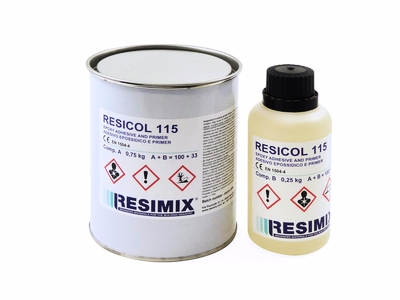RESICOL 115
SOLVENT-FREE EPOXY PRIMER AND COLD SHUT CASTING
Solvent-free, slightly thixotropic epoxy formulation. Recommended for construction joints and as a primer for epoxy mortars 205-210-212-250. Adhesive for laminating tanks and for enclosing carbon and glass fibre fabric (mesh and mats).
RESICOL 115 is a fluid, slightly viscous product, with a thixotropic behaviour up to 1.5 – 2 mm thick, capable of excellent adhesion to all building materials because it hardens without shrinking.
It reaches high mechanical properties within a few hours from application and it ensures:
- excellent adhesion to concrete, brick, stone, steel;
- excellent dielectric properties (low electric conductivity);
- excellent resistance to aggressive chemical reactants (acids and basics) and good resistance to solvents;
- easy to use thanks to pre-weighed packages.
It can be brush, roller or spray applied.
| U.M. | ||||||||||||||
|---|---|---|---|---|---|---|---|---|---|---|---|---|---|---|
| Compression strength UNI EN 12190 | 82 | N/mm2 | ||||||||||||
| Bending strength UNI EN 12190 25 | 45 | N/mm2 | ||||||||||||
| Linear shrinkage UNI EN 12617-1 | > 0,5 | mm/m | ||||||||||||
| Linear thermal expansion UNI EN 1770 | 9,3 x 10-5 | 1/°C | ||||||||||||
| Compression elastic modulus UNI EN 13412 | 4630 | N/mm2 | ||||||||||||
| Adhesion to dry concrete | > 4 | N/mm2 | ||||||||||||
| Adhesion to damp concrete | > 2 | N/mm2 | ||||||||||||
| Adhesion to steel UNI EN 12188 | ||||||||||||||
| angle 50° | 78 | N/mm2 | ||||||||||||
| angle 60° | 89 | N/mm2 | ||||||||||||
| angle 70° | 106 | N/mm2 | ||||||||||||
| Glass transition point (calorimetric method) | 60 | °C | ||||||||||||
| Viscosity | 2700 | cP | ||||||||||||
| Density | 1,2 | kg/dm3 | ||||||||||||
| A + B mixture ratio (normal and fast) | 100 + 33 |
The following table shows how adhesion on metal changes during hardening and in relation to the
temperature [N/mm2]
| Temperature | 10°C | 20°C | 30°C | |||||||||||
|---|---|---|---|---|---|---|---|---|---|---|---|---|---|---|
| Time | ||||||||||||||
| 6 h | - | 10 | 15 | |||||||||||
| 12 h | 6 | 16 | 22 | |||||||||||
| 24 h | 14 | 22 | 23 | |||||||||||
| 7 gg | 20 | 23 | 23 |
Preparation of the support
Sandblast, bushhammer and abrade the support to eliminate crumbly parts, traces of demoulding oils, fat, varnishes, latex concrete and remove dust with pressure air. Concrete must cure for at least a month.
Application on metals follows careful preparation of the support: remove oils, fats, varnishes and rust by abrading or sandblasting with white metal (SA2 – SA 3 degree).
Make sure the basement is clean, compact and dry: water has a negative effect on adhesion. Wet foundations must be dried up as much as possible using air or, better, using gas flame.
Preparation of the product
Pour component B into component A as per weight ration shown on the package.
Blend at slow speed for 3’ – 5’ using drill with helix/spiral to reduce air inlet as much as possible; during this operation, carefully scrape also the bottom and the sides of the package.
Application
Brush, roller or spray apply according to your needs.
Mortar is applied layer upon layer on the primer: is the latter is left to harden, it acts as detaching agents instead of fostering adhesion.
Notes
Packages are weight pre-measured out: fully use all components A and B. If you wish to divide the package, products must be weighed by respecting the A+B ratio on the label and must not be weighed out based on the volume.
Three essential rules are valid for all bi-component systems: weigh well, carefully mix bottom and walls, observe times of use.
| Temperature | Use (pot-life) | hardening | ||||||||||||
|---|---|---|---|---|---|---|---|---|---|---|---|---|---|---|
| 10 °C | 150' | 10 hours | ||||||||||||
| 20 °C | 25' | 4 hours | ||||||||||||
| 30 °C | 15' | 2½ hours | ||||||||||||
| 40 °C | 10' | 1½ hours |
By pouring B component into A component, the hardening reaction starts: following mixture the time
available is limited and it depends on the temperature
Used as primer, it ranges from 0.3 to 0.8 kg/m² based on support porosity.
To fix to a support (wood or concrete) and fill materials in synthetic fiber (carbon, glass or aramide), consumption ranges from 0.8 to 1.2 kg/m2.
Available in packages from 1 to 4 kg (A + B component).
If stored in its original and sealed package, the products remains unaltered for a year if kept in environments with a temperature between 10 and 30 °C.
- Hard structural gluing of different construction materials, e.g. concrete, iron, wood, brick, stone, marble, tuff and glass;
- Smoothing and sealing of holes in concrete walls;
- primer for epoxy mortars: RESIMALTA 204, 205, 210, 220 e 250;
- cold shut casting for rounded shells made with RESIMALTA 205/250;
- impregnation for gluing of materials and fibres in structural reinforcement with composite materials (carbon fibres, glass, aramide);
- impregnation of glass fibre spunbonded material for the creation of laminated coatings inside tanks which require high chemical resistance protection.

